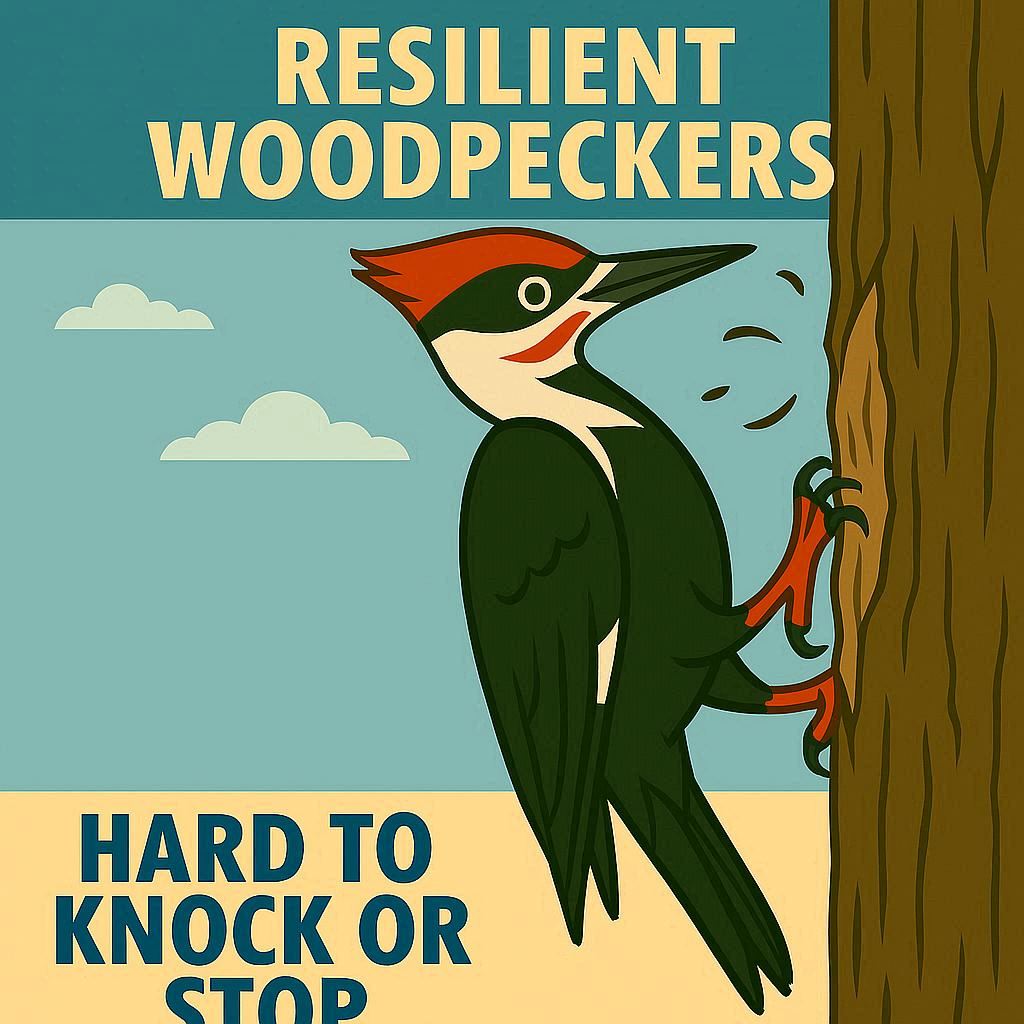
Woodpeckers, nature’s persistent excavators, are far more than noisy backyard pests. From the pristine fairways of major golf tournaments to the charred wilderness of national forests, these birds stand as an unlikely, yet potent, focal point in modern ecological, economic, and conservation debates. Their unwavering need for specific habitats—whether live, old, or dead trees—places them directly in the crosshairs of human commerce and land management, sparking complex discussions about endangered species, pest control, and logging policies.
The Red-cockaded Woodpecker and the “Safe Harbor” Compromise
The 2014 U.S. Open at Pinehurst, North Carolina, provided a surprising stage for a conservation success story. Right at the edge of the difficult 529-yard par-4 fourth hole, a federally endangered Red-cockaded Woodpecker (RCW) had chiseled a nest hole in an old, slightly bent Longleaf Pine. This event highlighted the delicate but possible coexistence between intensive private land use and critical species protection.
The RCW is a non-migratory bird that uniquely excavates its cavities in live Longleaf Pine trees at least 60 years old. Its historic range once covered an estimated 90 million acres of old-growth Longleaf Pine and wiregrass forest, an ecosystem shaped by frequent, low-intensity fires. Today, less than 3% of that original forest remains, primarily in scattered remnants.
Pinehurst’s success is a testament to the Safe Harbor program, a voluntary initiative by the U.S. Fish and Wildlife Service (FWS). This program was created to counteract the “defensive cutting” landowners practiced decades ago to avoid the burdensome federal regulations associated with hosting an endangered species.
The Carrot, Not the Stick: Safe Harbor offers flexibility and immunity. Landowners like Pinehurst are given a legal “mulligan”—no penalty for “incidental take” (accidental harm to a bird) that occurs on numbers above the initial population baseline.
Ecological Benefits: In return, Pinehurst maintains long-term conservation practices, such as keeping pines on a longer growth rotation and managing the mid-story to mimic a fire-cleared forest.
This compromise has allowed the 5,800 acres of “The Cradle of American Golf” to become a thriving nursery for nine RCW families, demonstrating that regulatory flexibility can be advantageous to both private enterprise and endangered birds.
The Black-backed Woodpecker: A Specialist in Burned Forests
At the other end of the habitat spectrum is the Black-backed Woodpecker, a true fire-dependent specialist found in the coniferous forests of the western mountains and the boreal north.

The Salvage Logging Showdown
The Black-backed Woodpecker is central to a fierce environmental and commercial conflict over salvage logging in recently burned forests, from California’s Stanislaus National Forest to the Black Hills of South Dakota.
Habitat Dependence:
To the human eye, a post-fire forest of charred snags (standing dead trees) may look desolate. To the Black-backed Woodpecker, however, it is a five-star dining experience. The fire-killed trees are rapidly infested by wood-boring beetles (Cerambycidae and Buprestidae), which are the woodpecker’s primary food source. The bird thrives in high-severity burn areas for approximately 2 to 8 years post-fire, coinciding with the peak of the insect outbreak.
The Conflict:
The blacked snags represent a massive financial windfall for logging interests. However, science overwhelmingly shows that salvage logging is detrimental to the species, with nest densities declining significantly in harvested areas. The removal of dead trees destroys both foraging and nesting habitat, threatening roughly 60 percent of the imperiled Black-backed Woodpeckers in affected regions.
Legal Action:
Conservation groups petitioned the FWS to list the Black-backed Woodpecker as threatened or endangered. In 2014, a lawsuit was filed against the FWS for failing to protect the bird from the Forest Service’s logging proposals, leading to a comprehensive FWS review of the species’ status.
The “Do-Nothing” Alternative
The scientific consensus, led by ecologists like David Foster of Harvard, often favors a no-management policy in the face of non-imminent threats like insect infestation or disease.
Research indicates that preemptive logging or excessive salvage harvesting can create a greater and more long-lasting impact on forest ecosystems than the disturbance itself.
Leaving dead trees standing provides crucial ecosystem services:
- Habitat for woodpeckers, nuthatches, and other cavity nesters.
- Nutrient cycling as the trees decompose naturally.
- Shelter and food for hundreds of insect species.
The Woodpecker as a Natural Pest Controller
Woodpeckers also provide an invaluable service as natural defense agents against invasive forest pests.
Feasting on the Emerald Ash Borer
The invasive Emerald Ash Borer (EAB) beetle, which arrived in the U.S. as a stowaway in wooden cargo pallets, is devastating millions of ash trees across the Midwest. On the good side of the woodpecker ledger, species like the Red-bellied Woodpecker are proving to be effective biological controls.
- A 2014 study found that woodpeckers can remove up to 85 percent of EAB larvae before they emerge.
- The dead ash trees, while a disaster for the ash population, create “excellent nurseries” for many species of woodpeckers and other birds, illustrating the resilience of the ecosystem to adapt to disaster.
The Ash-for-Cash Scheme
In a sharp contrast to this biological control, The Nature Conservancy was criticized for preemptively logging ash trees in a Pennsylvania preserve to obtain a “maximized financial return” by selling un-infested logs before the EAB arrived. This “ash-for-cash” scheme was defended as being “consistent with ecological science” that would somehow benefit other threatened species, a claim met with skepticism from leading ecologists who suggested the need for ash wood and income was the more understandable motive.
The Imidacloprid Threat
Furthermore, the conservation strategy for the Eastern Hemlock—a tree decimated by the Hemlock Wooly Adelgid—involves a controversial chemical: imidacloprid.
- The Neurotoxin: Imidacloprid is an insect neurotoxin that is highly toxic to invertebrates, including the Adelgids. However, it is strongly linked to the decline of bee and bird populations in Europe.
- Ecological Impact: Since it is a systemic insecticide, imidacloprid-injected trees may become devoid of all insects. This loss of food (caterpillars, beetles, etc.) represents a serious threat to insectivorous birds, including Pileated Woodpeckers, that forage in the preserve. Sublethal exposure in birds has been shown to cause neurotoxicity, resulting in reduced body mass, disrupted migratory behavior, and increased vulnerability to predators.
The Perpetual Knock: Woodpecker Damage and Deterrence
For the average homeowner and infrastructure manager, the woodpecker’s persistence is often viewed as a costly nuisance. Woodpeckers, especially Pileated Woodpeckers and flickers, cause an estimated $300 million per year in damages to homes, commercial buildings, utility poles, and even historic landmarks like Frank Lloyd Wright’s Spring House in Florida.
- Why they peck: They are often pursuing insects like carpenter bees boring into soft siding (like cypress), or they are excavating nest or roosting cavities. Utility poles, which resemble dead trees and often harbor insects despite preservatives, are a frequent target.
- Ineffective Solutions: A 2007 Cornell University study on damage deterrence found that artificial snakes and chemical repellents were ineffective. Furthermore, fake Prowler Owls sometimes attracted more damage.
- What Works: The most effective control methods tested involved:
- Mylar Tape: Flashing, reflective strips that work as a visual deterrent.
- Paint Color: Homes stained or painted in earth-tone colors suffered significantly more damage than those painted with bright pastel or white colors.
- Durable Finishes: Repainting cedar siding with solid acrylic paint rather than stain helped to keep insects out, thus removing the birds’ primary food source.
Despite the challenges, the legal status of the bird remains firm: woodpeckers are protected under the Federal Migratory Bird Treaty Act, making it illegal to kill them.
Comparison Table
| Woodpecker Species | Conservation Status & Habitat | Primary Ecological Role | Human/Economic Conflict | Key Management Issue |
| Red-cockaded Woodpecker (RCW) | Endangered; non-migratory. Nests only in old, live Longleaf Pine trees (60+ years). | Indicator Species of a healthy, fire-adapted Longleaf Pine ecosystem. | Low direct conflict; its presence historically created a regulatory hazard for landowners. | Success of the Safe Harbor program as a regulatory compromise to incentivize conservation on private property. |
| Black-backed Woodpecker | Status is under review (Petitioned for listing as Threatened/Endangered). Specialist in recently burned coniferous forests (snag habitat). | Key Specialist Species that follows and feeds on wood-boring beetle larvae in fire-killed trees. | Low direct conflict. | Conflict over Salvage Logging in burned forests, where commercial interests clash with the need to retain dead snags for habitat. |
| Red-bellied Woodpecker | Thriving/Increasing in many areas. Generalist; found in diverse forested habitats. | Natural Pest Control agent, primarily against the invasive Emerald Ash Borer (EAB). | Involved in structural damage (pecking) to homes and buildings. | Demonstrates the ecological benefit of a “no-management” approach, leaving EAB-killed ash trees standing as a food source. |
| Red-headed Woodpecker | Declining in some regions. Prefers open, disturbance-maintained woodlands, often found on golf courses with large, dead trees. | Secondary Pest Control; indicator of habitat with sufficient dead-wood structure. | Contributes to structural damage on homes and utility poles. | Conservation through wildlife-friendly golf course management, specifically retaining large dead hardwoods and dead limbs on live trees. |
A Resilient Species, A Complex Future
The story of the woodpecker—be it the Red-headed, Red-bellied, or the endangered Red-cockaded and Black-backed—is a microcosm of humanity’s evolving relationship with the natural world. They are creatures that both thrive on disaster (like the EAB epidemic and forest fires) and require carefully managed, fire-adapted ecosystems. They represent a fierce natural force hard to stop, demanding that land managers and conservationists move beyond simple binary choices to embrace nuanced solutions, regulatory compromises like Safe Harbor, and the ecological wisdom of a no-management approach when circumstances allow.

Hi, There and Welcome to BirdsNews.com, is here to help you learn and care about pet birds. and this blog is a journal of everything I’ve learned.
